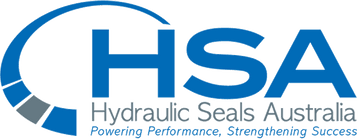One of the most common phrases we hear from customers is a simple request for a backup to sit behind the O-Ring on the outside of the gland. In principal this sounds like a simple request, and often it is, however knowing your groove size and the groove requirements for the O-Ring size are crucial in ensuring the best result for you and your hydraulic cylinder.
The perception that the idea of a backup is to completely fill the O-Ring or Seal groove is fundamentally wrong and in doing so, will cause issues with weeping, premature wear in dynamic use and most likely will result in damage on installation. The correct use of the backup is to close up the extrusion gap allowing for a increase in pressure the O-Ring, or seal, can handle before the material starts to extrude.
As with seals, O-Rings have a predetermined interference set by the groove cross section, in static sealing applications this is usually around 20%.. For example, a 3.53mm O-Ring requires a groove cross section (C/S) of 2.80mm, this ensures adequate compression and sealing force. As the O-Ring meets the lead in chamfer, the O-Ring starts to deform and begins to fill out the groove axially (L1), this happens as the volume of O-Ring remains constant and is constrained radially by the groove cross section. This cross section is determined by the major and minor diameters (D1 & d1). If the groove doesn’t allow for adequate axial elongation across the L1 groove then the O-Ring will be susceptible to pinching and being damaged on installation.

While damage on installation will likely be noticed during testing of the cylinder, another issue that can be experienced due to the O-Ring not having enough room won’t be found out until later, usually once the cylinder is in use on the designated equipment. While the O-Ring has a predetermined amount of interference built into it, the O-Ring needs to react and respond to the hydraulic fluid pressure and any fluctuations the cylinder experiences. As the oil pressure increases, the more oil flows into the groove and the sealing force exerted by the O-Ring increases as a reaction for the increase in cylinder pressure. When there is no room for this to happen, the hydraulic fluid will work its way around the O-Ring and begin to weep past. It is also common for the effect of extrusion to begin to present its self as the pressure increases, this is where the purpose of the backup presents itself.

For decades the traditional O-Ring or O-Ring and Backup combinations have been a staple in hydraulic cylinders, and while this has proven successful, modern solutions are taking hold and presenting options that offer enhanced performance. These “GS” seals most notably run a double diamond design with four contact points that increase in radial force as the pressure increases creating a exceptional , leak free sealing barrier. The unique profile offers substantial extrusion resistance, tolerates eccentricity and ovality and resists high pressure damage that traditional O-Rings are susceptible to. As part of the unique profile, the risk of pinching or catching on installation is minimised making these seals ideal for threaded gland arrangements and while predominantly used to replace a O-Ring and Back up, the GS profile can be manufactured to suit any custom or oversized housings offering further advantages over traditional arrangements.





